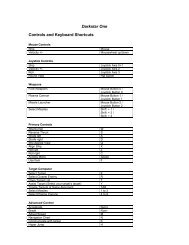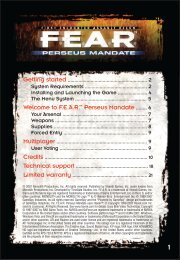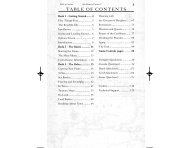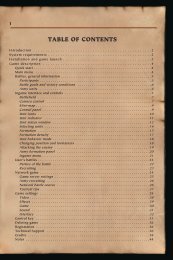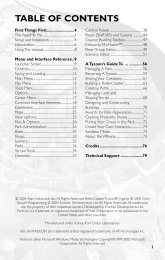Heads-Up Display Modes 35 - Metaboli
Heads-Up Display Modes 35 - Metaboli
Heads-Up Display Modes 35 - Metaboli
You also want an ePaper? Increase the reach of your titles
YUMPU automatically turns print PDFs into web optimized ePapers that Google loves.
118 Air Combat Basics<br />
Homing<br />
The most effective type of guidance against evasive targets is homing, when the<br />
missile guidance system gets information about the target and produces control<br />
commands on its own. Thus, the control post does not guide the SAM.<br />
For active homing, the SAM illuminates the target and receives the signals<br />
reflected off the target. In the case of semi-active homing, the source of<br />
illumination (tracking radar) is located at the control post, and the SAM receives<br />
signals reflected from the target. Passive homing systems use heat or light<br />
emitted by the target to estimate the parameters of the target’s motion.<br />
In general, homing systems operate in the following way: while the SAM rests on<br />
the launcher, its seeker is locked onto the selected target, and the parameters of<br />
the target’s motion are being measured. After launch the SAM seeker tracks the<br />
target, estimates the tracking error, and produces control commands<br />
independently from the ground.<br />
Combined Guidance<br />
As the name implies, some missiles combine guidance methods to improve<br />
performance. The Kub (Cube) SAM system (SA-6A Gainful) is an example of a<br />
system with combined guidance. This system employs radio-command guidance<br />
on the initial part of the missile trajectory and homing when closing in on the<br />
target. This provides high accuracy at long range.<br />
SAM Engagement Envelope<br />
Like air-to-air missiles, SAMs have specific engagement envelopes. Firing at<br />
targets within the heart of the envelope increases the likelihood of a hit. Just like<br />
air-to-air missiles, the envelope varies based on the target’s range, altitude, and<br />
aspect. In the engagement diagram shown, the area defined by the numbers 1, 2,<br />
3, 4, and 5 represent the missile’s effective area. Note that this envelope shifts if<br />
the target is moving toward the launcher, in the area defined as a, b, c, d, e. In this<br />
case, the missile must be fired at longer range since the target will fly part of the<br />
way into the missile. If the missile is fired too late (once the target has crossed<br />
the a, b, c line), it passes out of the envelope before the missile arrives.<br />
Typical SAM engagement envelope





